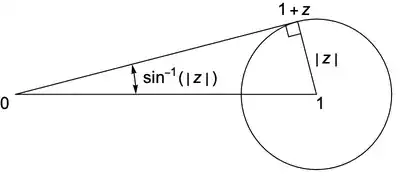Using the methods from this answer, we show the following:
$$
\begin{align}
\left|\frac{\left(1+\frac{z}n\right)^n}{\left(1+\frac{z+\delta}n\right)^n}\right|
&=\left|\,1-\frac\delta{n+z+\delta}\,\right|^n\tag{1a}\\
&\ge\left(1-\frac{|\delta|}{n-|z+\delta|}\right)^n\tag{1b}\\[3pt]
&\ge1-\frac{n\,|\delta|}{n-|z+\delta|}\tag{1c}
\end{align}
$$
Explanation:
$\text{(1a)}$: distribute the exponent over the quotient
$\phantom{\text{(1a): }}$simplify the quotient
$\text{(1b)}$: triangle inequality (twice)
$\text{(1c)}$: Bernoulli's Inequality
$$
\begin{align}
\left|\frac{\left(1+\frac{z+\delta}n\right)^n}{\left(1+\frac{z}n\right)^n}\right|
&=\left|\,1+\frac\delta{n+z}\,\right|^n\tag{2a}\\
&\ge\left(1-\frac{|\delta|}{n-|z|}\right)^n\tag{2b}\\[3pt]
&\ge1-\frac{n\,|\delta|}{n-|z|}\tag{2c}
\end{align}
$$
Explanation:
$\text{(2a)}$: distribute the exponent over the quotient
$\phantom{\text{(2a): }}$simplify the quotient
$\text{(2b)}$: triangle inequality (twice)
$\text{(2c)}$: Bernoulli's Inequality
Therefore,
$$
1-\frac{n\,|\delta|}{n-|z|}\le\left|\frac{\left(1+\frac{z+\delta}n\right)^n}{\left(1+\frac{z}n\right)^n}\right|\le\frac1{1-\frac{n\,|\delta|}{n-|z+\delta|}}\tag3
$$
Furthermore,
$$
\begin{align}
\left|\,\arg\left(\frac{\left(1+\frac{z+\delta}n\right)^n}{\left(1+\frac{z}n\right)^n}\right)\,\right|
&=n\left|\,\arg\left(\frac{1+\frac{z+\delta}n}{1+\frac{z}n}\right)\,\right|\tag{4a}\\
&=n\left|\,\arg\left(1+\frac{\delta}{n+z}\right)\,\right|\tag{4b}\\[3pt]
&\le n\sin^{-1}\left(\frac{|\delta|}{|n+z|}\right)\tag{4c}\\[3pt]
&\le\frac\pi2\frac{n\,|\delta|}{n-|z|}\tag{4d}
\end{align}
$$
Explanation:
$\text{(4a)}$: distribute the exponent
$\phantom{\text{(4a): }}$$\arg\left(z^n\right)=n\arg(z)$
$\text{(4b)}$: simplify the quotient
$\text{(4c)}$: $|\arg(1+z)|\le\sin^{-1}(|z|)$
$\text{(4d)}$: $\sin^{-1}(x)\le\frac\pi2x$ for $0\le x\le1$
$\phantom{\text{(4d):}}$ triangle inequality
For $|\delta|\lt\frac12$ and $n\ge2|z|+1$, $(3)$ gives the thin annulus
$$
1-2|\delta|\le\left|\frac{\left(1+\frac{z+\delta}n\right)^n}{\left(1+\frac{z}n\right)^n}\right|\le\frac1{1-2|\delta|}\tag5
$$
and $(4)$ gives the thin sector
$$
\left|\,\arg\left(\frac{\left(1+\frac{z+\delta}n\right)^n}{\left(1+\frac{z}n\right)^n}\right)\,\right|\le\pi|\delta|\tag6
$$
As $\delta\to0$, the intersection of the annulus and the sector tend to $1$:

Concerning $\bf{(4c)}$
In the justification of $\text{(4c)}$, it is claimed that
$$
|\arg(1+z)|\le\sin^{-1}(|z|)\tag7
$$
As illustrated below, the maximum of $\arg(1+z)$ is attained on the tangent to the circle of radius $|z|$ centered at $1$. In that arrangement, $\arg(1+z)=\sin^{-1}(|z|)$. Symmetry gives $(7)$.


